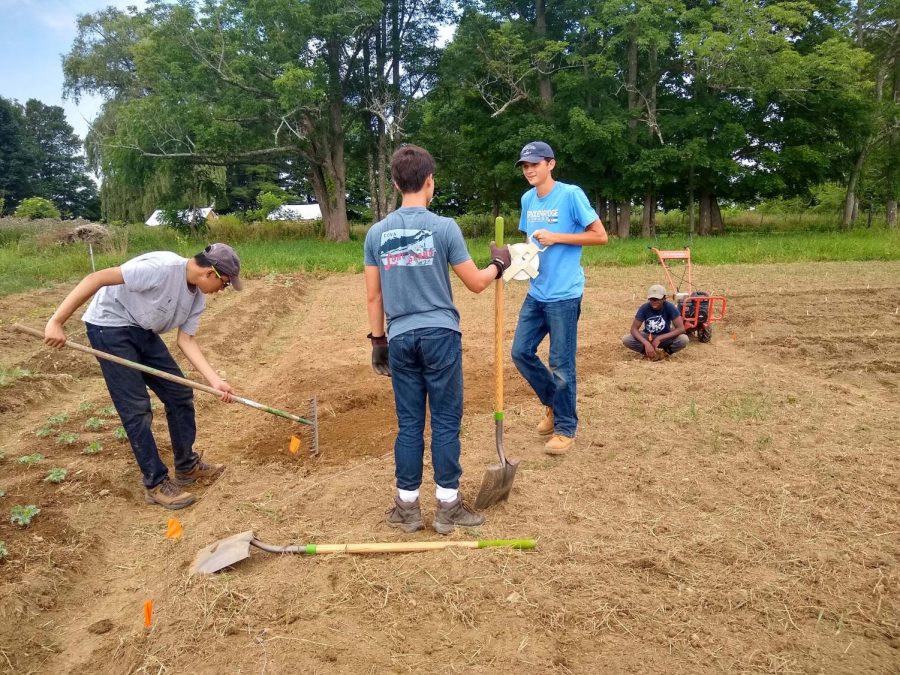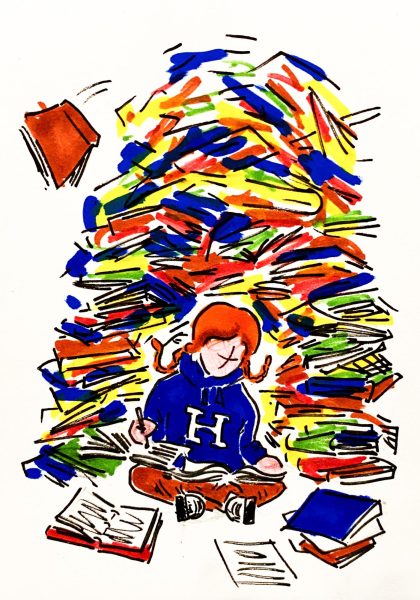The World Beyond: The Future of Environmental Science
Students work at the Fairfield Farm last summer.
The Features editors reached out to Ms. Jennifer Rinehart, instructor in environmental science, to get an inside look into the school’s environmental science program.
How does taking an environmental science help a student grow?
Any exposure to scientific processes, regardless of discipline, is an opportunity for students to mature as thinkers. Certainly, I feel it is vital that our students are exposed to the scientific facts behind issues so heavily debated in the political realm – issues like climate change, EPA regulation and government oversight, endangered species and habitat loss concerns, fire management, access to food, and environmental justice.
How are the environmental science courses expanding?
Environmental science courses will be evolving next year extensively, as we move away from the College Board’s AP curriculum. Mr. Oostenink and I have been working on a set of [new] courses for the past [four] years, tossing around ideas, exploring options and gathering feedback from our fellow science instructors, that would expand and deepen the experiences for interested students.
Our goal is to pair place-based education with real-world research in environmental issues. The Agroecology course taught this summer for the first time, in partnership with the Summer Portals program, is a good example. While exposing students to the process of growing food, similar to the work of FFEAT, we examined the greater issues of a regional food system and the scientific approach to agricultural land management. Last summer, the [Agroecology] students set up the first rounds of [on-site] experiments at Fairfield Farm and visited many local producers to gain a feel for agricultural concerns in our adjacent food shed.
Next year, we will expand this work. This spring, I am working with [Keith] Matanachai ’22 to expand that research into deciphering soil mycology (fungal) associations to improve soil productivity for specific crops. He will plan and implement the next round of experiments this spring and work on data collection during this summer’s Agroeco class. In the fall, we will work together to summarize and explore his data.
Along these same lines, we are currently testing the curriculum for a class in Forest Ecology to begin next fall. And we will be authoring a Conservation Biology class to start [during the] spring of 2021. Finally, we are exploring options for a two-semester Climate Science class.
What has been your experience as an environmental scientist?
I am an aquaculturist, wildlife biologist, and forester by training. I spent most of my masters and initial doctoral work studying environmental policy and law. I grew up on and around farming on the Eastern Shore of Maryland, where chicken production in large operations was the norm.
My first official studies were of the offal dispersed around the Shore from poultry trucks and its effect on freshwater systems. My next study looked at [the] development of erosion barriers to protect the Shore’s waterways from agricultural runoff.
In college, I worked with a team to evaluate the use of Gap Analysis in Costa Rican wildlife conservation. I’ve studied Roosevelt elk management in Oregon, land-use planning in Georgia and authored the Comprehensive Wildlife Conservation Strategies for South Carolina.
Environmental science is an interesting “discipline,” in that it actually isn’t a discipline unto itself. Really what we study is the application of the principles of physics, chemistry, and biology to living, uncontrolled systems outside of the lab. That’s what makes our studies exciting! We put the principles you learn in other classes to work in the field in experiments you can’t entirely decipher without acknowledging that the answers to all of our questions usually begin with “it depends.”
I was told once that in every environmental problem, the answer is “90% people, 10% nature” and so I think it is vital to keep questioning but also educating the next generation of decision-makers. And the value of that education is not in explaining exactly how these systems work but rather in teaching students how to find the answers for themselves, how to read the research, how to explore the questions that they will surface on their own.
What makes the environmental science program at Hotchkiss unique?
Look around. We are surrounded by opportunity here. In the land, in the history of the land, in the availability of interesting questions and proximity to research partners we could help answer them.
Consider even the lowly tick that carries Lyme disease, the source of so many admonitions to remember your “tick checks” when you explore our lovely forests. Ticks, as vectors of several concerning diseases, are the focus of cutting edge ecological research here in New England. This research pulls from principles of ecology, infectious disease, medicine, chemistry, and climatology.
We also increasingly have an incredible team of educators in all corners of our school with a passion for exploring and understanding the world outside our doors.





